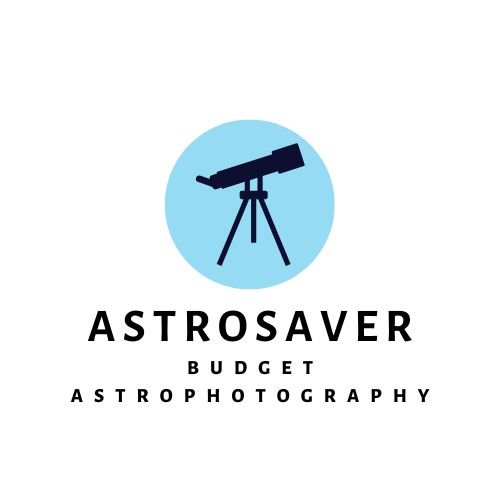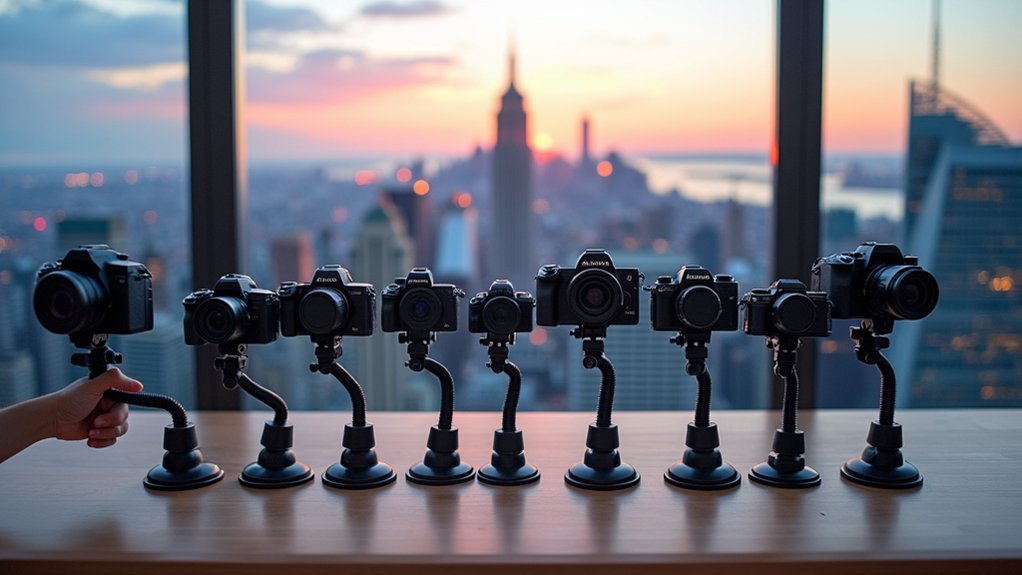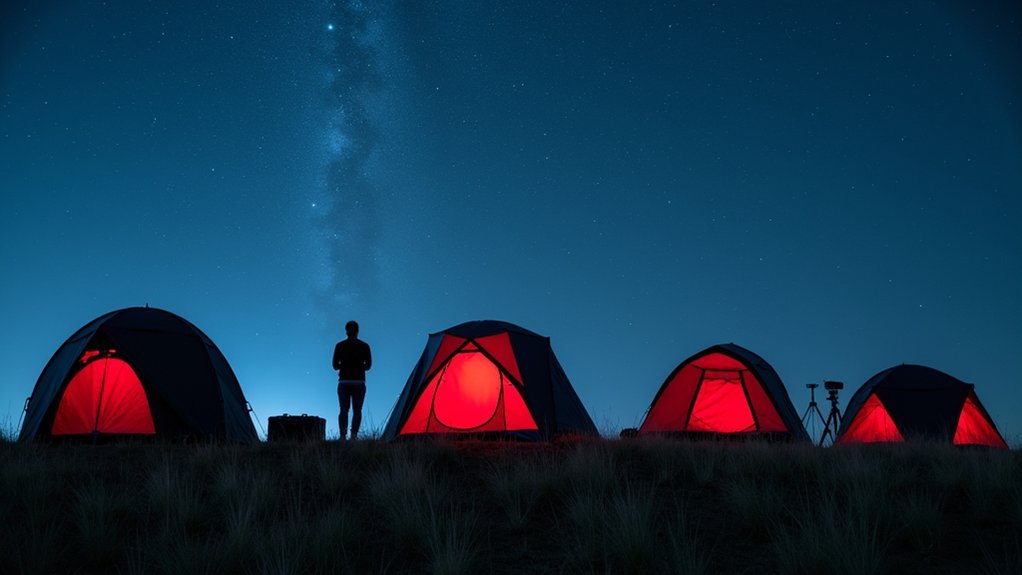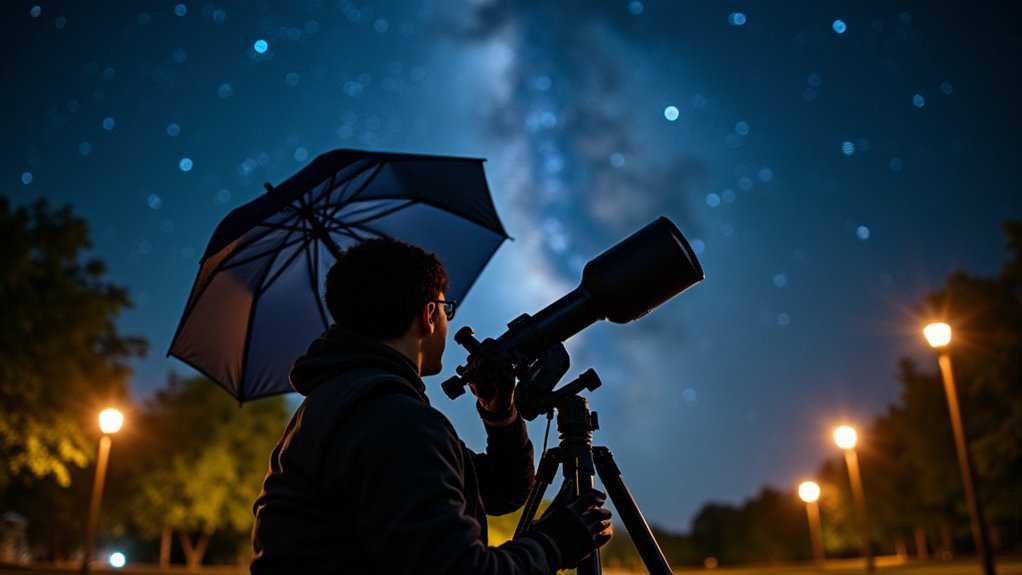Choosing the right eyepiece projection adapter can transform your astrophotography results without breaking the bank. You’ll find that these specialized tools connect your camera to your telescope, allowing you to capture stunning details of celestial objects that would otherwise remain elusive. Whether you’re shooting with a Nikon, Canon, or Pentax, the market offers affordable options that deliver professional-quality results. So what makes these five adapters stand out from the rest? Let’s compare their features.
Telescope Camera Adapter for Nikon SLR Camera
Nikon DSLR owners looking to capture the cosmos will find this telescope camera adapter an essential bridge between Earth and the heavens. This versatile adapter supports both prime-focus and eyepiece-projection techniques, accommodating eyepieces up to 38mm.
You’ll appreciate its compatibility with numerous Nikon models—from the D40 to D810—though mirrorless cameras aren’t supported. The extendable design with T2-Ring connection makes switching between capturing detailed moon craters or full nebulae straightforward.
Users praise its solid construction, though some suggest the interior could benefit from a matte black finish to reduce reflections. With a 4.3-star rating, it’s a reliable choice for your astrophotography journey.
Best For: Nikon DSLR camera owners who want to explore astrophotography through their telescope without investing in specialized astronomical cameras.
Pros:
- Compatible with a wide range of Nikon DSLR models, from entry-level D40 to professional D810 series
- Versatile design accommodates both prime-focus and eyepiece-projection photography techniques
- Extendable tube allows for zoom adjustments and fits eyepieces up to 38mm for enhanced detail capture
Cons:
- Not compatible with Nikon mirrorless cameras, limiting its use for photographers who have transitioned to newer systems
- Some users report difficulties achieving prime focus with certain telescope models
- Interior lacks matte black finish, which can cause unwanted reflections that reduce image quality
Astromania Telescope Camera Adapter for Astrophotography
The Astromania Telescope Camera Adapter stands out as a versatile solution for both beginner and intermediate astrophotographers seeking high-magnification images of celestial objects.
With its anodized aluminum construction and 34mm scale markings, you’ll achieve precise focal length adjustments for capturing lunar craters and planets. The adapter works with both refractor and reflector telescopes featuring 1.25-inch eyepiece connections.
Users praise its solid build quality and straightforward setup, though some setups may require additional components. At just 6.4 ounces with full extinction threading to eliminate light reflection, this #9 bestseller balances durability with performance for immediate prime focus or eyepiece projection photography.
Best For: Amateur astronomers and beginner astrophotographers looking to capture detailed images of the moon, planets, and other celestial objects using their existing telescope with a DSLR or mirrorless camera.
Pros:
- Durable anodized aluminum construction with full extinction threading to eliminate light reflection
- Versatile design compatible with both refractor and reflector telescopes with 1.25-inch eyepiece connections
- Precise 34mm scale markings allow for accurate focal length adjustments for optimal magnification
Cons:
- May require additional components (like a Barlow lens) for certain camera and telescope combinations
- Limited compatibility information provided, which might create confusion for first-time users
- Some users report needing to make adjustments or modifications for specific camera setups
Variable Extension Telescope Camera Adapter for Pentax SLR Cameras
Pentax DSLR users looking for versatile astrophotography solutions will find the Variable Extension Telescope Camera Adapter an essential tool in their imaging arsenal. This T2-Ring adapter (model SB-PK01) offers impressive flexibility for different celestial targets.
You’ll appreciate its dual functionality—use it with an eyepiece (up to 38mm) for detailed moon crater shots or without for capturing the full moon and nebulae. The adjustable extension between front and rear barrels lets you zoom to achieve your desired magnification.
At just 10.8 ounces, it’s lightweight yet sturdy. With a 4.2-star rating, it’s a reliable choice, though incompatible with mirrorless cameras.
Best For: Pentax DSLR owners who want versatile astrophotography capabilities, from detailed moon craters to wide nebula shots, all in one adaptable telescope accessory.
Pros:
- Adjustable extension offers flexible magnification for different celestial targets
- Compatible with eyepieces up to 38mm for enhanced imaging possibilities
- Lightweight design (10.8 ounces) makes it easy to handle during extended night sessions
Cons:
- Not compatible with Pentax mirrorless camera systems
- Some users report compatibility issues with specific Pentax DSLR models
- May require experimentation to find optimal extension settings for different targets
1.25 Variable Telescope Camera Adapter for Astrophotography (Canon EOS Compatible)
Canon DSLR photographers looking for versatility in their astrophotography setup will find the Variable Telescope Camera Adapter an essential tool for their arsenal. This all-metal adapter fits standard 1.25″ telescopes and works with a wide range of Canon EOS models from the 5D series to Rebel lines.
You’ll appreciate its dual functionality—supporting both prime focus and eyepiece projection photography. The matte black anodized aluminum construction prevents unwanted light reflection during night sessions. At just 10.8 ounces, it’s sturdy without adding excessive weight to your equipment. Users consistently praise its precise machining and solid performance, making it a worthwhile investment at #136 in the telescope adapter rankings.
Best For: Astronomy enthusiasts with Canon EOS cameras who want to pursue both prime focus and eyepiece projection astrophotography with standard 1.25″ telescopes.
Pros:
- All-metal construction with anodized aluminum provides durability and prevents light reflection during night photography sessions
- Versatile functionality supporting both prime focus and eyepiece projection photography methods
- Compatible with a wide range of Canon EOS camera models from professional 5D series to entry-level Rebel lines
Cons:
- Not compatible with spotting scopes, limiting its use to astronomical telescopes only
- At 10.8 ounces, may add noticeable weight to some telescope setups
- Limited to Canon EOS cameras unless additional adapters are purchased separately
Gosky 1.25-inch Variable Telescope Camera Adapter for Astrophotography
Versatile and durable, Gosky’s 1.25-inch Variable Telescope Camera Adapter stands out for serious astrophotographers who need flexibility in their imaging setup. Its all-metal construction with anodized aluminum guarantees longevity while providing two essential photography methods.
You’ll appreciate the adapter’s dual functionality—use it for prime focus photography or eyepiece projection depending on your subject. The variable design lets you adjust magnification to perfectly frame celestial objects.
The T2 thread connects to your camera’s T-ring (sold separately), while the opposite end fits standard 1.25-inch focusers. This compatibility with DSLR and SLR cameras makes it a practical choice for capturing detailed astronomical images.
Best For: Amateur and intermediate astrophotographers looking for a versatile, durable adapter that allows both prime focus and eyepiece projection methods with their DSLR or SLR cameras.
Pros:
- All-metal construction with anodized aluminum ensures durability and longevity
- Variable design allows magnification adjustment for perfect framing of celestial objects
- Compatible with standard 1.25-inch focusers and works with various camera brands via T-rings
Cons:
- Requires additional purchase of camera-specific T-ring (sold separately)
- May require some technical knowledge to achieve optimal results with different configurations
- Limited to 1.25-inch focusers only, not compatible with larger 2-inch telescope ports
Factors to Consider When Choosing Eyepiece Projection Adapters for Astrophotography: 5 Affordable Options Compared
When selecting an eyepiece projection adapter for your astrophotography setup, you’ll need to evaluate several critical factors beyond just price. Camera compatibility should be your first consideration, followed by extension tube length, eyepiece size limitations, and the overall build material quality of the adapter. We’ll compare five budget-friendly options that deliver excellent performance without breaking the bank.
8 Subheading Discussion Points
Selecting the right eyepiece projection adapter can dramatically impact your astrophotography results, especially if you’re working within budget constraints. When comparing options, prioritize camera compatibility first—many adapters designed for DSLRs won’t work with mirrorless systems without additional parts.
Look for adapters made from anodized aluminum, which reduces unwanted light reflections while providing durability for field use. Variable extension capabilities should be a key consideration, as they’ll allow you to adjust magnification for different celestial targets.
Don’t overlook the maximum eyepiece diameter accommodation—this determines which eyepieces you can use with your setup. Finally, read through user reviews carefully to identify potential issues with specific telescope or camera combinations that might affect your particular imaging workflow.
Camera Compatibility Matters
Although many astrophotographers focus primarily on optical quality, camera compatibility should be your first consideration when selecting an eyepiece projection adapter. Many adapters are designed exclusively for specific SLR or DSLR brands like Nikon, Canon, or Pentax, and won’t work with mirrorless cameras.
You’ll need a T-ring matched to your camera brand to guarantee a secure connection between your camera and telescope. Also verify that the adapter accommodates your telescope’s eyepiece diameter—typically up to 1.25 inches for most models.
Don’t overlook your camera’s weight; some adapters can’t effectively support heavier DSLRs without additional stability features. Before purchasing, check customer reviews from photographers with similar setups to identify potential compatibility issues others have experienced with your specific equipment.
Extension Tube Length
The length of your extension tube directly impacts how you’ll capture celestial objects through eyepiece projection. Longer tubes provide greater flexibility when photographing larger celestial bodies at prime focus, while shorter options work better for detailed shots of smaller objects.
Most adapters accommodate eyepieces up to 38mm (1.49 inches) in diameter, so consider your existing equipment when selecting an adapter. You’ll want to verify the tube length complements your specific astrophotography goals.
Some premium adapters feature measurement scales for precise focal length adjustments, which greatly improves your ability to achieve ideal focus. When comparing models, look for those offering variable extension capabilities—this zoom adjustment functionality enhances image clarity and magnification without requiring you to switch between multiple fixed-length adapters.
Eyepiece Size Limitations
Most eyepiece projection adapters accommodate eyepieces up to 38mm (1.49 inches) in diameter, creating a critical limitation you’ll need to take into account before purchasing. This standard size works with many common telescope eyepieces, but you should verify your existing equipment’s compatibility before investing.
For ideal results, you’ll want to use fixed eyepieces rather than zoom models, as they typically deliver superior image quality when projecting celestial objects. When selecting an adapter, pay close attention to the focal length of your eyepieces, as this directly impacts your final image quality and magnification.
Some adapters require specific adjustments for prime focus, particularly with certain telescope models. Checking these compatibility details in advance will save you frustration and guarantee your astrophotography setup performs as expected.
Build Material Quality
High-quality materials determine both the longevity and performance of your eyepiece projection adapter, making this factor critical to your astrophotography success. Look for adapters crafted from anodized aluminum, which offers superior resistance to corrosion and wear during long observation sessions.
The best adapters feature matte black interiors that minimize light reflections, dramatically improving your final image quality. Pay attention to the adapter’s body thickness—thicker designs provide more stable support for your camera attachment, reducing vibration during exposures.
You’ll want full extinction threads in the construction to eliminate light leaks that could compromise your celestial images. Additionally, don’t dismiss an adapter’s weight; heavier models often indicate more solid construction that will withstand frequent use and provide reliable performance for years to come.
T-Ring Connection Types
Selecting the right T-Ring connection type stands as a fundamental prerequisite for successful astrophotography, as this small but critical component bridges your camera to the telescope system.
T-Rings are brand and model-specific, meaning you’ll need to match yours to your camera’s particular lens mount. Don’t assume a universal fit exists—Canon, Nikon, Sony, and other manufacturers each require their own dedicated T-Ring designs.
What makes T-Rings versatile is their standard T2 thread on the telescope side, allowing seamless connection to various eyepiece projection and prime focus adapters. When choosing your setup, verify compatibility between your DSLR/SLR and the T-Ring to avoid frustrating alignment issues.
Remember that proper T-Ring selection directly impacts your focus capability and final image quality, particularly when using eyepiece projection techniques.
Prime Focus Capabilities
Although eyepiece projection excels at high-magnification lunar and planetary imaging, prime focus capabilities represent an essential feature when selecting your adapter system. This technique connects your camera directly to the telescope without an eyepiece, maximizing light gathering and image quality through the full telescope aperture.
When you’re capturing larger celestial objects like the entire moon or gas nebulae, prime focus delivers superior results. Most quality adapters support this functionality, making them versatile for various astrophotography applications. You’ll want to guarantee your chosen adapter allows for precise adjustments specific to your telescope model.
For the best image quality and clarity, opt for adapters that work with fixed eyepieces in prime focus configurations. This combination will greatly enhance your ability to photograph distant celestial subjects with remarkable detail.
Magnification Adjustment Range
The precise magnification adjustment range of your eyepiece projection adapter determines what celestial objects you’ll effectively capture. Look for adapters with variable extension tubes that accommodate eyepieces up to 38mm in diameter, giving you flexibility to frame different celestial targets perfectly.
The best adapters feature precise focal length adjustment capabilities, allowing you to fine-tune your magnification for ideal image clarity. You’ll want an adapter that lets you easily switch between prime focus photography and eyepiece projection, expanding your effective magnification range for both wide-field and detailed close-up imagery.
Quality adapters often incorporate thicker bodies with full extinction threads that minimize light reflection at higher magnifications. These design features contribute greatly to image clarity when you’re pushing the boundaries of your telescope’s magnification capabilities.
Frequently Asked Questions
How Do Eyepiece Projection Adapters Affect Image Magnification?
Eyepiece projection adapters increase your image magnification by projecting the eyepiece’s image onto your camera sensor. You’ll get higher magnification than prime focus, with the amount depending on the eyepiece and projection distance.
Can I Use These Adapters With Schmidt-Cassegrain Telescopes?
Yes, you can use eyepiece projection adapters with Schmidt-Cassegrain telescopes. They’re actually well-suited for SCTs since these telescopes already provide good magnification and the adapter will help you capture detailed celestial images.
What’s the Difference Between Eyepiece Projection and Prime Focus Photography?
In eyepiece projection, you’re using an eyepiece between your telescope and camera for magnification. With prime focus, you’re connecting your camera directly to the telescope, fundamentally using the telescope as a camera lens.
Do These Adapters Work With Planetary Imaging Cameras?
Yes, these adapters work great with planetary cameras. You’ll need the right size attachment for your camera, but you’ll get increased magnification that’s particularly useful for capturing detailed views of planets and the Moon.
How Do I Calculate the Effective Focal Length When Using Projection?
To calculate effective focal length with projection, multiply your telescope’s focal length by the projection factor. You’ll find this factor by dividing the distance from eyepiece to camera sensor by the eyepiece’s focal length.





Leave a Reply